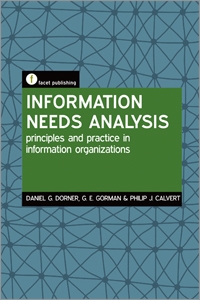
Primary tabs
You don't need to be an ALA Member to purchase from the ALA Store, but you'll be asked to create an online account/profile during checkout to proceed. This Web Account is for both Members and non-Members. Note that your ALA Member discount will be applied at the final step of the checkout process.
If you are Tax-Exempt, please verify that your account is currently set up as exempt before placing your order, as our new fulfillment center will need current documentation. Learn how to verify here.
- Description
- Table of Contents
- About the authors
- Reviews
If you want to provide an information service that truly fulfills your users' needs, this book is essential reading. Analyzing and assessing the information needs of clients is key to the provision of effective service and appropriate collections in both face-to-face and virtual library services. The importance of information needs analysis is widely recognized by information professionals, but currently there is little substantive, detailed work in the professional literature devoted to this important topic. This new book is designed to fill that gap, by supporting practitioners in developing an information needs analysis strategy, and offering the necessary professional skills and techniques to do so. It will offer guidance to team leaders and senior managers in all areas of library work, especially those involved in collection management, service provision and web development, and is equally applicable to the needs of academic, public, government, commercial and other more specialized library and information services. The text adopts a hands-on, jargon-free approach, and includes relevant examples, case studies, reader activities and sources of further reading. Key areas covered include:
- what is information needs analysis?
- how is needs analysis conducted?
- what are the varieties of needs analysis?
- how are analyses evaluated and reported?
Examination copies are available for instructors who are interested in adopting this title for course use.
1. Background to needs analysis for information managers
- Introduction
- Information needs analysis rather than information needs assessment
- Understanding the concept of need
- Defining ‘needs' in relation to ‘wants' and ‘demands'
- Defining information needs analysis
- Types of information needs
- Reasons for conducting an information needs analysis
- Review of Chapter 1
- Further reading
- References
2. The importance of context in information needs analysis
- Introduction
- The cultural context
- Information needs awareness in context
- Purpose and perceived importance
- Determining the communities
- Making use of existing data
- Review of Chapter 2
- Further reading
- References
3. Models and types of information needs analysis
- Introduction
- The literature
- The system approach
- The target group approach
- The contexts of needs assessments
- Comparing the perspectives
- Information needs analyses in information management contexts
- Review of Chapter 3
- Further reading
- References
4. The stages of information needs analysis
- Introduction
- Four stages of needs analysis
- The recursive nature of INA research
- Qualitative and quantitative frameworks for data analysis
- The stages of ex post intervention
- Review of Chapter 4
- Further reading
- References
- Appendix 4.1: Gantt chart
5. Gathering data for information needs analyses
- Introduction
- How we have reached this juncture
- The primary research question
- The research population
- The data-gathering method
- Data analysis
- Validity and reliability
- Ethical considerations
- Practical issues to consider when choosing a method
- The main data-gathering methods
- Examples of data-gathering methods selected in INAs
- Review of Chapter 5
- Further reading
- References
6. Gathering data from existing sources
- Introduction
- The data
- External data
- Internally created data
- The methods
- Conclusion
- Review of Chapter 6
- Further reading
- References
7. Gathering data through surveys
- Introduction
- What is a survey?
- Planning for a survey
- Conducting a survey
- Preparing for data analysis
- Review of Chapter 7
- Further reading
- References
8. Gathering data through interviews
- Introduction
- Thoughts on managing qualitative data collection
- Interviews
- Focus groups
- Observation
- Other qualitative methods
- Review of Chapter 8
- Further reading
- References
9. Analysing and integrating information needs analysis data
- Introduction
- Analysing and integrating information
- The information analysis stage in the INA process
- Qualitative data
- Quantitative data
- Descriptive statistics
- Inferential statistics
- Review of Chapter 9
- Further reading
- References
10. Reporting on an information needs analysis
- Introduction
- The audience and its impact on the final report
- Validity and reliability
- The writing process
- The structure of an INA report
- The use of graphics
- Other means of communicating the results
- Review of Chapter 10
- Further reading
- References
Daniel G. Dorner
Daniel G. Dorner is Senior Lecturer at the School of Information Management, Victoria University of Wellington, New Zealand.
G. E. Gorman
G. E. Gorman is Professor of Library and Information Management at the School of Information Management, Victoria University of Wellington, New Zealand.
Philip J. Calvert
Philip J. Calvert is Senior Lecturer at the School of Information Management, Victoria University of Wellington, New Zealand.
"The authors have plenty of experience and expertise to instruct the reader on information needs analysis ... recommended for libraries that contain information science and management collections."
— Catholic Library World


